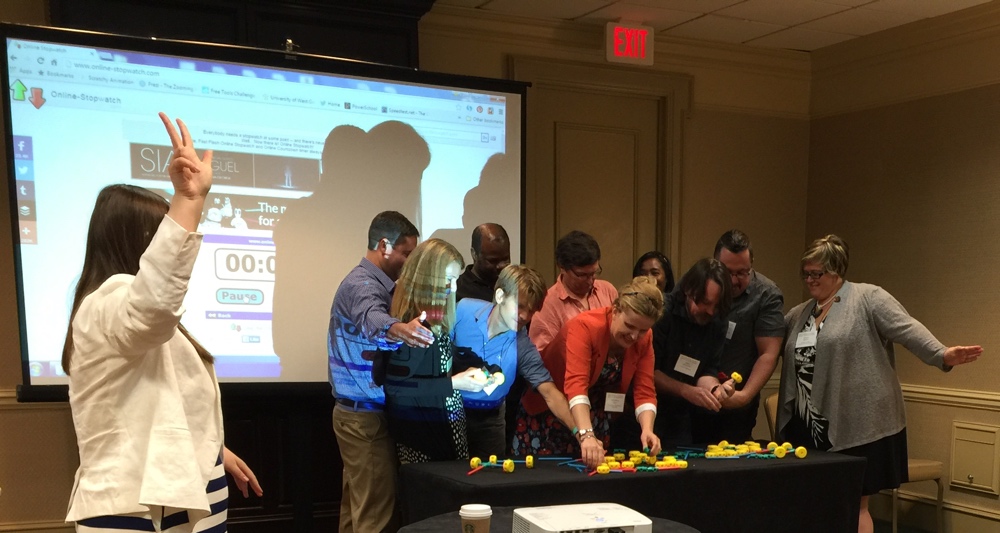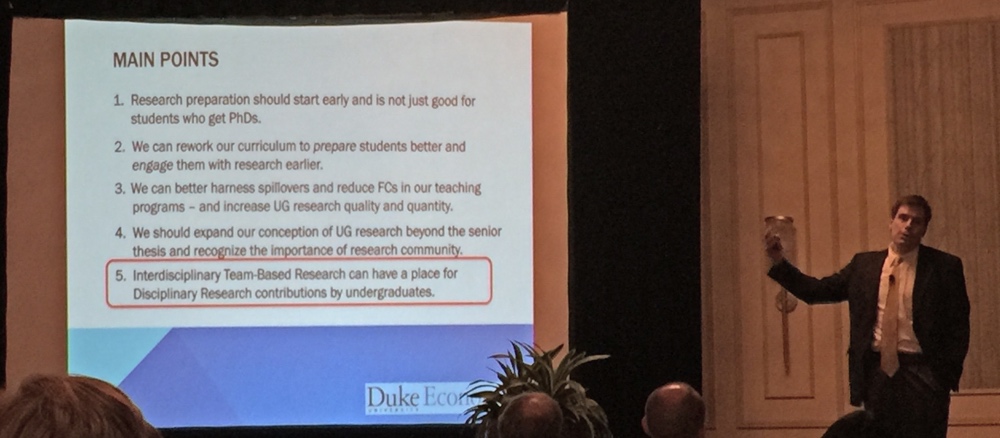CTREE 2016: My First Economics Teaching Conference
I’ve been to economics conferences before. When you meet someone new, the first question is almost always “What are you working on?” The Conference on Teaching and Research in Economics Education (CTREE) is fundamentally different. Over my three days in Atlanta, almost every conversation I had started with “What do you teach?”
Being around a whole bunch of economists focused on teaching for three full days was amazing. I reconnected with my UCL friends. I got to meet several Internet friends in person for the first time. I made a whole slew of new friends. And I got lots of ideas for things to try in my own classes.
There are two kinds of presentations at this conference, and I think both are valuable. The first are stories about things folks have tried in their own classes or programs–My own paper fell firmly in this category. I presented about my experience with lecture capture in Fall 2015, and showed what happened with class attendance and performance on exams. I’m not estimating the causal effect of using lecture capture, but I am pointing out interesting patterns and speculating about the processes underlying them.
The second kind of paper is what I hope to be writing more of during the next few years: true Scholarship of Teaching and Learning. These papers pose an important question, review the literature to place the research in context, and answer some small version of that question with a rigorous empirical approach. In theory, most faculty should be good at this since it’s how we approach our disciplinary research. In practice, it’s a tremendous amount of work that should be better rewarded in the field.
Chiara Lombardini (Helsinki) presented joint work with Hanni Muukonen and Minna Lakkala that pushed forward our understanding of the difference between a lecture class with some active learning, a partially flipped class, and a fully flipped class. They taught exactly the same material in each way over three years and compared learning outcomes and satisfaction. At this point, the evidence is pretty clear that learning outcomes are far better in courses with active learning (including flipped classes) than in traditional lecture courses, but we don’t know enough about the optimal type or quantity of active learning. In this context (a Principles of Economics class at the University of Helsinki), the partially flipped class seemed to have the best outcomes. The complete results are quite interesting and I highly recommend asking Chiara for a copy of the paper so you can read the whole thing.
I also left the conference with a long list of web sites and tools to investigate:
- Most folks teaching Principles already know about MyEconLab, but it was new to me and it looks like a great resource.
- Proctortrack is an online exam monitoring service that integrates machine learning algorithms that automatically identify suspicious behavior. This has the potential to be much cheaper and maybe even more reliable than purely human-based proctoring solutions.
- MobLab has a whole host of web-based games that instructors can easily integrate into their classes to give students real almost tactile experience with concepts like non-cooperative equilibria, gains from trade, and auctions.
- The Economics Network has loads of resources for teachers of economics and those interested in economics education more broadly.
- Alan Green (Stetson) uses the free version of NearPod to do in-class polling. It looks powerful, with features like open-ended questions and “draw-it” activities that remind me of Learning Catalytics.

In the Thursday plenary session, Susan Laury (Georgia State) told us how and why she plays economic games with her students during class. She gave us some great examples, but I was most intrigued the one she didn’t describe in detail called “the babysitter game.” I think it’s based on the Capitol Hill Babysitter Coop, and if it’s not, someone should definitely create a game based on this real world event because it would be a fantastic way to explain money supply.
Over dinner at the Atlanta Fed, Rebecca Stein (Penn) told our table how she starts every class of her Principles course with a song related to the topic of the day (e.g., heterogeneous skill endowments). It gets students thinking, and when the song is over, she’s ready to lecture. I am so stealing this idea for my next big lecture class.

You won’t be surprised to learn the funnest session I went to was the one about incorporating play into the classroom. Kim Holder (West Georgia) has her Principles students play Monopoly with the twist that they start with unequal endowments. Susan Reilly (FSCJ) uses Play-Doh to demonstrate decreasing marginal production while Chelsea Dowell (Upper Iowa) does the same with Tinker Toys. Helen Roberts (UIC) explains the 2008 Financial Crisis with a simple but very effective coin-flipping game.

I found Thomas Nechyba’s talk on how and why we should get undergraduate students involved in research incredibly inspiring. The Duke Economics Department runs semester-long senior essay workshops so students aren’t working in isolation with their advisors. They’ve carefully analyzed several years’ worth of senior essays and found that the quality has gone up substantially since they started the workshops. They’ve created interdisciplinary teams of faculty and students to work on tough problems through the Bass Connections program. And they’ve overhauled the curriculum to give undergraduates the tools they need for research as early as possible. If only more departments would be this willing to try new things.
My only complaint about the conference is that it went by too fast, but I’m already looking forward to attending in 2017 in Denver!